

Venus transited the sun on June 5, 2012, and was visible from my home in San Diego. It was unsual to have clear skies in the late afternoon, and the transit was not that interesting, so I did not prepare to take the best possible images. Coincidentally, only 10 feet away on my patio was a brand new Televue NP127is refractor telescope with a Finger Lakes ML16000 cooled monochrome camera. This superb combination was being used for nighttime imaging tests for a government work project, but had no solar filter. Instead, I used my five-year old Panasonic Lumix DMC-LX1 camera, a point-and-shoot model with a maximum 25.2mm focal length. At this focal length, Venus's sillouette (58 arcsec= 280 urad) was only 7 microns, or 3 pixels across (at 2.2 microns/pixel). The images here are the best ones out of 50. I used welding filters to attenuate the brightness. The best exposure was 1/200 sec at F/5.6, using a tripod. The photos here were taken about 3:43 pm and 4:14 pm PDT.
These are single images, with no processing. The green layer was well exposed, but the red and blue layers were practically black. To get better results, I took the five or nine of the best images for additional processing. I converted the images to monochrome, up-sampled 2x for better resolution, then aligned the images to 1/2 pixel before averaging the frames. The results are shown here.
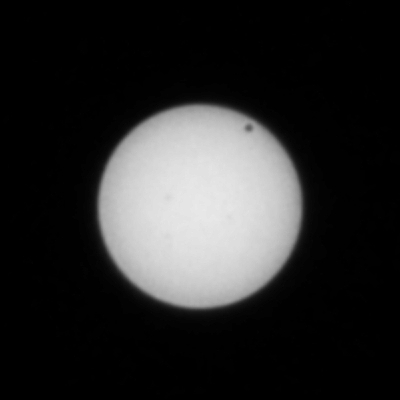
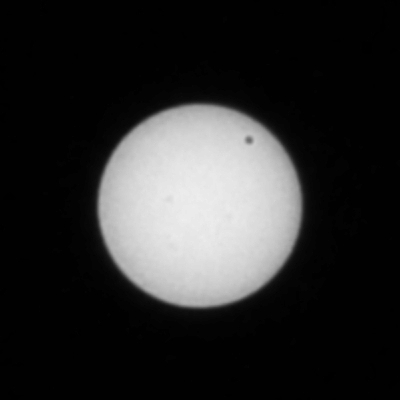
These are not as good as using even a small telescope, and are not too different than if one used a pinhole camera. The largest three sunpots are barely visible. For the 2017 total solar eclipse, I will be much better prepared. Those cameras will be on pre-programmed mode or fully automatic, so I can enjoy totality with my eyes to the fullest possible extent.
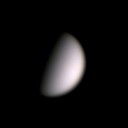
Venus, March 6, 2004. Magnitude-4.2, 19 arcsec diameter, 62% illuminated.
Taken with Philips ToUcam; best 10% of 2000 images taken at 10 FPS, 1/250 sec exposure, Gain = 0, Barlow 2.5x 2x (F/33).
The planet was just above the roof of my house. This evening I was able to take images of Venus, Mars, Jupiter, and Saturn. We had a respite from the clouds due to an off-shore breeze, but that also made the seeing even worse. Click on the image to see the first 50 frames from the AVI file.

Venus, January 10, 2004. Magnitude-4.0, 13.4 arcsec diameter, 81% illuminated.
Taken with Philips ToUcam; best 10% of 1000 images taken at 10 FPS, 1/250 sec exposure, Gain = 0, Barlow 2.5x 2x (F/33).
This is a test image to determine exposure. The altitude was about 26 degrees, so the seeing was marginal. Click on the image to see the first 50 frames from the AVI file.
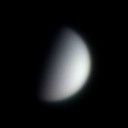
Venus, December 29, 2000. Magnitude -4.2, 60% illuminated, 20.3 arcsec diameter.
RGB image taken with 9" Newtonian, F/60, 0.11 second exposures in red, blue, and green filters. Since the exposure was so short, image stabilization was not used. Many images were taken and only the best images were selected. Since the image does not change (like Jupiter), the images did not have to be consecutive. The images were then processed with MaxImDL and combined and converted to jpeg.
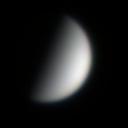
Venus, January 14, 2001. Magnitude -4.4, 52% illuminated, 23.7 arcsec diameter.
Image taken and processed the same as the December 29, 2000 image. The phase is a little smaller, but the size is larger, giving a slightly brighter planet.
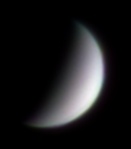
Venus, February 3, 2001. Magnitude -4.5, 41% illuminated, 30 arcsec diameter.
Image taken and processed the same as the December 29, 2000 image. The phase is still smaller, but the size is even larger, giving a yet slightly brighter planet.
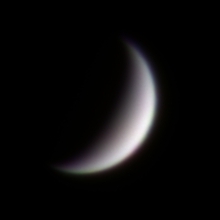
Venus, February 20, 2001. Magnitude -4.6, 28% illuminated, 38 arcsec diameter.
Image taken and processed the same as the December 29, 2000 image. The phase is still smaller, but the size is even larger, giving the brightest possible planet. The planet is also closer to the horizon at sunset, so it is more difficult to get the highest resolution. No pictures with a smaller phase or larger diameter were possible this cycle, due to weather and a high local horizon west of my telescope.
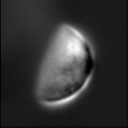
Venus, December 29, 2000. Magnitude -4.2, 60% illuminated, 20.3 arcsec diameter.
The color images from this date were processed to enhance any cloud features. Instead of using unsharp masking, the red image was subtracted from the blue image. Any difference between the colors must be indicative of Venus's clouds. To test the technique, two blue images taken on different parts of the CCD were subtracted; a flat, featureless image resulted. The edges, of course, are very sensitive to alignment and small ripple in the image, so that part of the image should be ignored. The bright area on the top center and the darker area near the center probably represent actual features. If anyone can confirm these features, for example, with infrared or ultraviolet imagery, I'd like to hear from them!
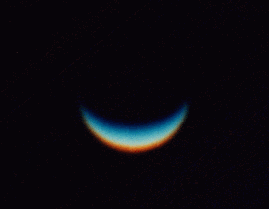
I've been told that, because surface features can't be seen, photographing Venus is not very interesting. Not necessarily true! Shown above is the crescent Venus taken on March 4, 1993, which shows interesting coloration. At 6:37 p.m., I used the AO-2 adaptive optics system on an 8" SCT , stopped down with an elliptical, off-axis 3" by 5½" mask, using eyepiece projection to give an effective focal length of 30 meters. The best Venus exposure shown here on Kodak Ektar 25 film required 10 seconds. The large image and the microfine grain of the color print film combined to make the practically grainless image. The seeing was good when looking straight up, but deteriorated tremendously toward the horizon. The off-axis mask helped reduce fine-structure atmospheric turbulence, since the planet twinkled only 26° above the horizon. The reduced resolution due to the small mask diffraction effects was offset by the reduced turbulence errors. Differential atmospheric refraction caused the color fringes. The calculated red-blue color fringing should be about 1½ arcseconds, which agrees well when compared with the 44 arcsecond planet diameter. On March 4, Venus hovered practically directly over the Sun in azimuth, creating a horizontal crescent, balancing the color fringing. This provided the pleasing photographic colors. The AO-2 stabilized the image to a fraction of an arcsecond; the residual turbulence and telescope diffraction limited the photo resolution to about 1½ arcseconds in the wide mask direction, and about 2 arcseconds in the narrow mask direction. The image above was digitally scanned from an original print from the negative.
All text and images are owned by Stellar Products, 1992-2012. Any use by others without permission of Stellar Products is prohibited.
Return to the Image Gallery index page
Return to Stellar Products home page